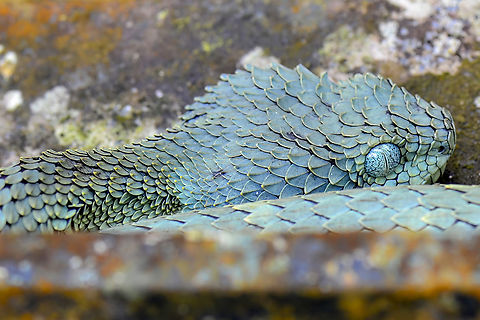
Appearance
"Atheris squamigera" grows to an average total length of 46 to 60 cm, with a maximum total length that sometimes exceeds 78 cm. Females are usually larger than males.The head is broad and flat, distinct from the neck. The mouth has a very large gape. The head is thickly covered with keeled, imbricate scales. The rostral scale is not visible from above. A very small scale just above the rostral is flanked by very large scales on either side. The nostrils are lateral. The eye and the nasal are separated by 2 scales. Across the top of the head, there are 7 to 9 interorbital scales. There are 10 to 18 circumorbital scales. There are 2 rows of scales that separate the eyes from the labials. There are 9 to 12 supralabials and 9 to 12 sublabials. Of the latter, the anterior 2 or 3 touch the chin shields, of which there is only one small pair. The gular scales are keeled.
Midbody there are 15 to 23 rows of dorsal scales, 11 to 17 posteriorly. There are 152 to 175 ventral scales and 45 to 67 undivided subcaudals. It is possible that there is a variation in morphometric characters related to habitat:
...snipped...
The coloration is the same in some populations, but variable in others. The dorsal color varies from sage green or light green to green, dark green, bluish, olive or dark olive brown. Rare specimens may be found that are yellow, reddish or slate gray. The scales have light-colored keels and sometimes yellow tips that form a series of 30 or more light crossbands or chevrons. On the tail, there are 10 to 19 chevrons: not always clearly defined, but usually present. The ventral edge of the dorsum has light spots in pairs. An interstitial black color is visible only when the skin is stretched. The belly is yellow or dull to pale olive; it may be uniform in color, or heavily mottled with blackish spots. The throat is sometimes yellow. The tail has a conspicuous ivory white tip, 7 to 12 mm long, extending back over 10 subcaudals.
Neonates have a dark, olive coloration with wavy bars, paler olive or yellowish olive with fine dark olive margins, bars at 5 mm intervals, and a belly that is paler greenish olive. The adult color pattern develops within 3 to 4 months.
Naming
Common names for "A. squamigera" include green bush viper, variable bush viper, leaf viper, common bush viper, bush viper, and tree viper, Hallowell's green tree viper.Habitat
"Atheris squamigera" inhabits mostly rainforest, preferring relatively low and thick flowering bushes.Reproduction
In the wild "A. squamigeras" begin reproducing once they reach sexual maturity at 42 months for females, and at 24 months for males respectively. Reproduction takes place once annually, most often during the wet season. "A. squamigera" is viviparous, and a single successful pairing can produce up to 19 neonates, although the average is 7–9. The female "A." "squamigera" carries her young internally during a gestation period of two months. Following birth, the neonates are abandoned by the mother as they are born venomous and entirely self sufficient."Atheris squamigera" requires a very high level of humidity to breed. In one case, males and females were kept separate from January to the end of November. Two females became gravid. Each produced eight young: a smaller percentage were yellow, most being green. In each brood, there was also one nonviable green specimen. Some of the neonates fed readily on frogs, while the others had to be force-fed pinkie mice. All fed independently after a few months.Food
The diet of "Atheris squamigera" consists primarily of small mammals, although cases of cannibalism within the species have been documented."A. squamigera" is a nocturnal hunter and its coloring allows it to blend in with its environment and ambush the small prey it feeds on. It is equipped with two front hollow fangs through which it injects its prey with hemotoxic venom rendering it defenseless.
Defense
Bites from "A. squamigera" have resulted in at least one report of severe hematological complications as well as two deaths. Although no specific antivenom is made for the genus "Atheris", antivenom for the genus "Echis" has been shown to be partially effective in neutralizing "Atheris" venom.References:
Some text fragments are auto parsed from Wikipedia.